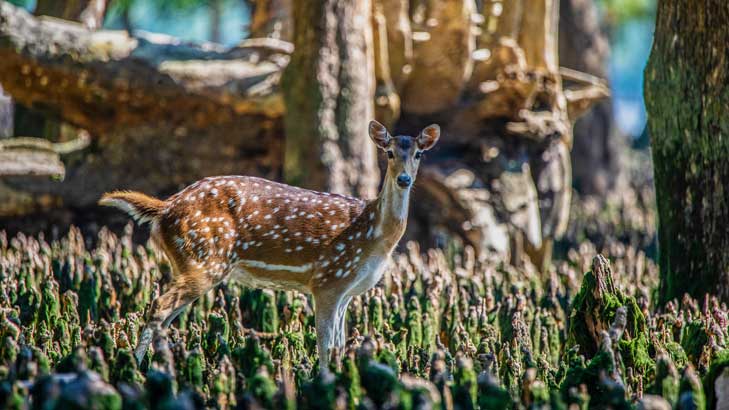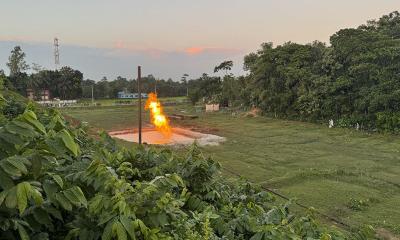-4 pairs of chitra deer to 20,000 deer were found in Nijhumdwip at that time
- Crowd, building, trawlers, dense habitant are main problem
The natural green belt of Nijhumdwip and its biodiversity are constantly under threat due to the impact of changing adverse climate and storm surges. Unplanned human settlement in the areas adjacent to the Nijhumdwip National Park and reserved forests has put the areas near the protected areas at risk. In the face of continuous human and natural disasters, the existence of the Chitra deer, one of the components of the island's environment and biodiversity, has reached its peak.
In the brief history of the island, it is known that the char that emerged from the sea in the 1950s was called Ballar Char. A part of the extensive sandy coastline was full of Uri and Bheulla national grasslands.
In the 1960s, due to the location of the char, a settlement of Bathanis was established for fishermen and cattle and buffalo rearing. At that time, the place has been named Char Osman also. Amidst the heavy loss of life here in the 1970 cyclone, a woman miraculously survived trapped in a Keora tree. Later, she came to be known as Kerpa Buri. The green-walled island created by the Forest Department created a replica of the Sundarbans. In 1975, the then MP Amirul Islam Kalam named it Nijhumdwip after seeing the peaceful appearance of the green forest.
In his interest, when the Forest Department released 4 pairs of chitra deer, a new horizon for chitra deer began in Nijhumdwip. The green-walled trees standing near the vast sea beach of Nijhumdwip developed into a sanctuary for deer migration. Tourists from home and abroad also flock to Nijhumdwip to see the magical scene of the aesthetic migration of thousands of chitra deer. In 1997, Prime Minister Sheikh Hasina declared the promising Nijhumdwip a national park. In 2001, it was gazette as a national park and a protected forest. According to locals, more than 20,000 deer were found in Nijhumdwip at that time. At that time, tourists used to go to the forest to get deer horns. Many tourists can also be seen buying deer horns.
Tajul Islam, a former member of Nijhumdwip, said that once upon a time, herds of deer could be seen in the forest during sunrise and sunset. Due to the gatherings of deer, farmers struggled to protect their crops even with nets. Now, deer are not seen running across the plains in Nijhumdwip.
He said that the herds of deer used to go to drink water in two ponds for fresh water, how could the ferocious dogs of the island know. Many deer died in dog attacks while drinking water.
Local Abdullah Al Mamun said that the area of reserved forest in Nijhumdwip is not even 5,000 acres. The continuous settlement in the buffer zone of the reserved forest has made the habitat of deer unsafe. The free movements of people, the sound of trawlers in the canals, the movement of cows and buffaloes, have turned the natural environment cramped for the deer. The CPG and locals are of the opinion that there may be very few deer at present.
In the changed situation of declaring Nijhumdwip as a union, the formation of a task force committee under the direction of the High Court for the coexistence of forests and humans and the installation of boundary pillars of the reserved forest have not been implemented, and the biodiversity of the island is under extreme threat. Taking advantage of the failure to determine the boundaries of the reserved forest, land grabbers have not stopped cutting trees in the reserved forest, occupying land and constructing structures. Conscious circles, including tourists, are blaming the irresponsibility of the interdepartmental offices, especially the local forest department, for the installation of boundary pillars of the reserved forest.
Meanwhile, a large number of deer were washed away from Nijhumdwip due to the strong flow of storm surges. The washed-up deer are sheltered in the nearby Char Kabira, Dhal Char, Jaglar Char, Char Bahauddin, Char Kalam, Ghasiar Char, and Suryamukhi forests. But the deer that have taken shelter in unprotected areas are being sold by illegal hunters for Tk 500 per kg. Although the influential people from the neighboring upazilas, with the help of local groups, occasionally hunt and smuggle deer, most of them remain hidden.
Non-governmental development worker Dulal Uddin said that tourists are seen expressing disappointment at not being able to see the deer. Due to the lack of proper conservation of natural habitats in the reserved forests, the economic utility of biodiversity, entertainment, and tourism industries have not yet developed in Nijhumdwip. Jahajmara Range Officer Saiful Islam said that Nijhumdwip and Jahajmara Union, which are included in the 11 chars under the government gazette, are spread over an area of 40,390 acres.
The forest department does not have any statistics on how many deer are in the Nijhumdwip area. However, deer are roaming in the surrounding pastures. In this regard, District Forest Officer Abu Yusuf said about the Nijhumdwip Task Force, we recently had a meeting. The process of setting up boundary pillars of the reserved forest is involved with the survey work of the Land Ministry. Since the declaration of the union, human settlement in the deer sanctuary is increasing day by day. Forest and people cannot coexist. Moreover, the people of Nijhumdwip have to reduce their dependence on the forest. They have to be more aware and compassionate towards the forest, he said.
ZH






